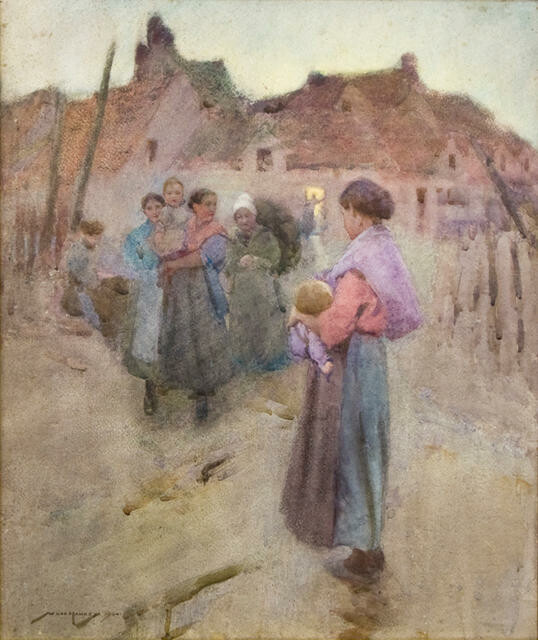William Lee-Hankey
British, b.1869, d.1952
The Village Gossip
- 1900
- Watercolour
- Sir Joseph Kinsey Collection. Gifted by Lady Kinsey, 1936
- 860 x 760mm
- 69/561
Tags: buildings (structures), children (people by age group), families, houses, infants, mothers, people (agents), urban landscapes, women (female humans)
Brought to light, November 2009- 22 February 2011
William Lee Hankey favoured rural village scenes and in this work the title offers a clue to the narrative being played out before us. The subject of the village tittle-tattle is the woman in the foreground holding a child, most likely born out of wedlock. In contrast to the child who is embraced with confidence by the gossiping women, her grasp of her baby is tentative and uncomfortable. They bar the way to the houses in the background in which a figure, possibly the illegitimate child’s father, stands silhouetted against the warm light that emanates from the interior beyond.
Exhibition History
Genre painters, who focused on the lives of the French and British fishermen and coastal villagers, were very popular during Victorian times. Their romantic scenes usually presented idealised views or captured the moments of drama in village life. Here the interaction of the villagers, as conveyed by the poses and positions of the figures, adds a narrative element to the soft-edged forms of the watercolour. The viewer is invited to ponder on the scene, as the young woman, who is holding the small child, is isolated from the main group, while a man's figure is highlighted against the open doorway. The artist has also used the title to direct the thoughts of the viewer and to contribute to the mood. (Before 2003)
Idealised rural village scenes were popular during Victorian times. William Lee Hankey here gives a little drama, with the young woman and child isolated from the main group. The title of the work invites the viewer to guess what they are saying about her. During the early 1900s Hankey moved to France where he painted peasant subjects almost exclusively. He was influenced by the French artist Bastien-Lepage (1848-1884), who painted scenes of French peasant life in an idealised realist manner. Lee-Hankey was also a successful printmaker in the early 1900s, with many of his rural subjects being produced as prints. Born in Chester, England, Hankey studied at the Chester School of Art, the Royal College of Art, South Kensington, and in Paris. Back in London he began exhibiting at the Royal Academy in 1896. Lee Hankey was President of the Royal Sketch Club from 1902 to 1904. On active service during World War I, he served with the Artists’ Rifles in Flanders in 1915.
(Opening Gallery hang, May 2003)

